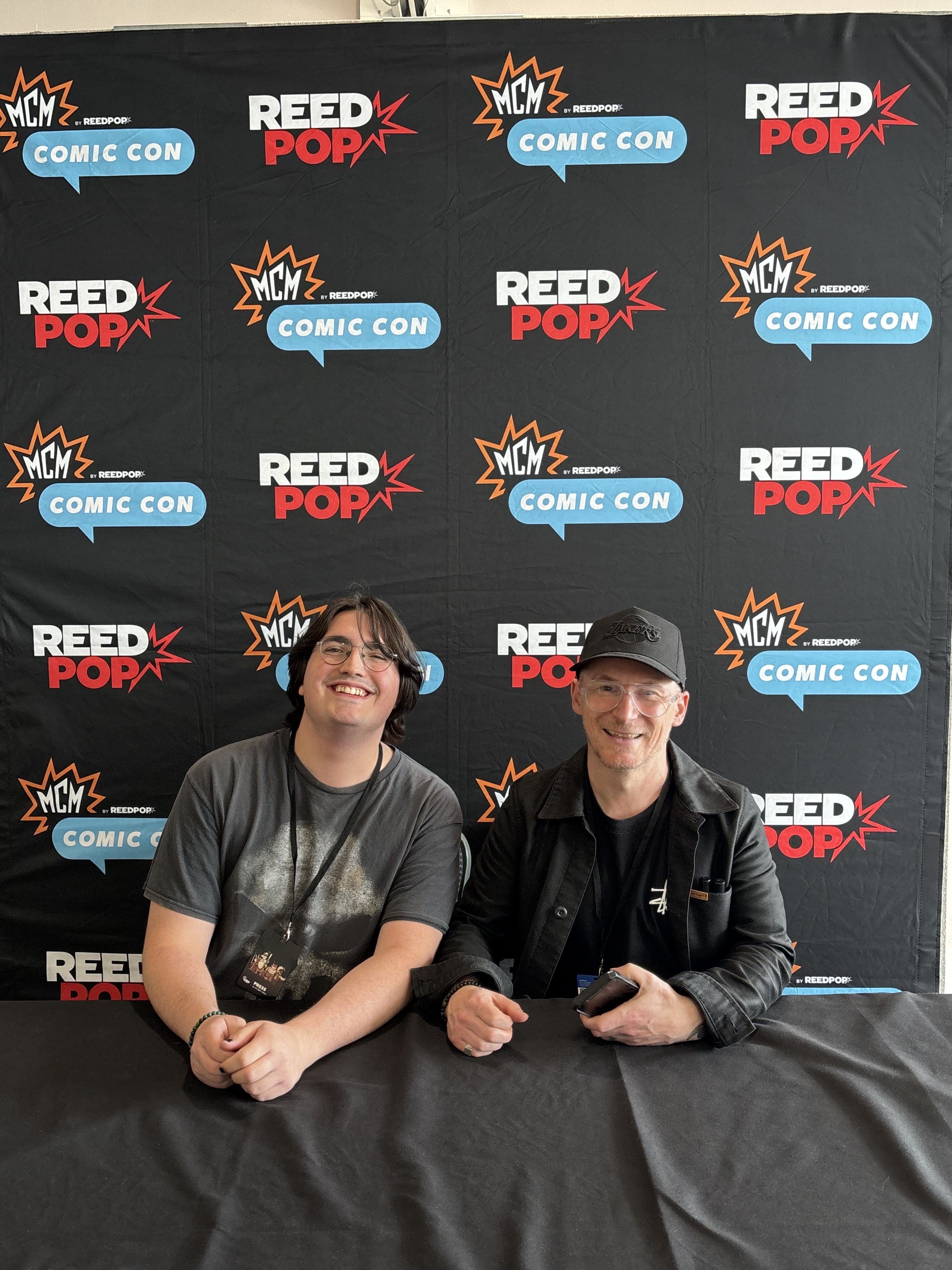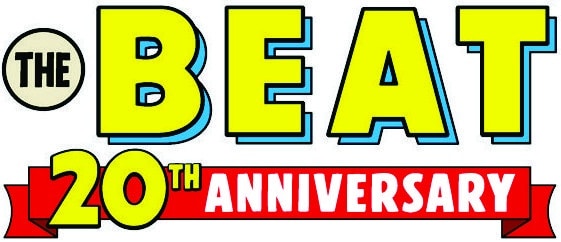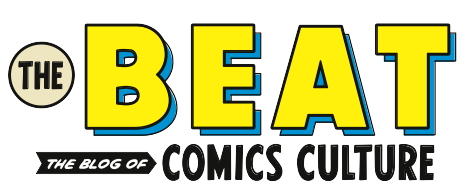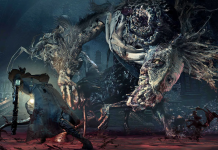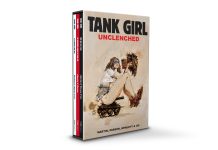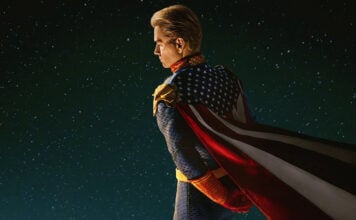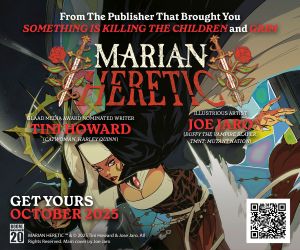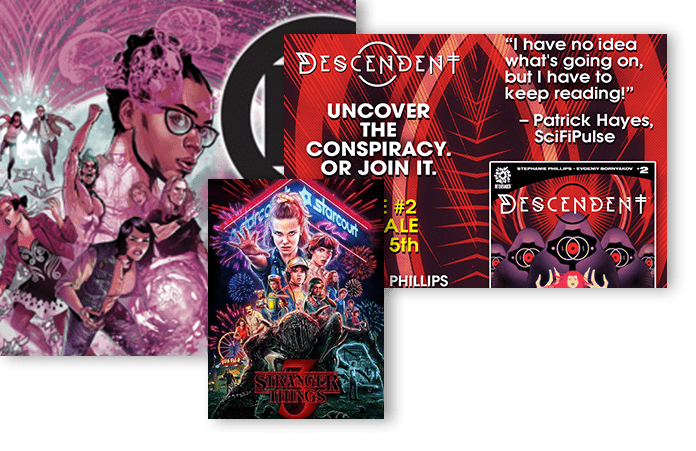Phoo Action: Deluxe Edition released last year from Titan Comics to universal praise. A longterm labour of love by writer Mat Wakeham, it not only collects the entirety of Jamie Hewlett’s Get The Freebies, but an entire follow-up prose novel by Wakeham, behind the scenes material, process artwork and extensive design information and history on how the project evolved over time. It’s a behemoth of a book, but it’s worth every penny you spend on it, with every choice feeling like a deliberate and well-crafted addition to a massive tome that’s easy to dive in and hard to put down.
The Beat sat down with Wakeham to discuss the book, it’s history, and how to make art authentic to yourself.
This interview has been edited for clarity.
JARED BIRD: Hello, and thank you so much for your time. The deluxe edition rerelease of Phoo Action came out last December from Titan Comics. Why do you think the world of Phoo Action still resonates with readers after all this time?
MAT WAKEHAM: I think because at its heart, despite it being written in the late 90s and set in the 00s, it’s still about human stories. It adopts tropes and ideas associated with superheroes, supervillains, and with celebrities, which are cultural touchpoints and integral to the human experience. There’s a human truth to it. It’s like asking why Superman still resonates.
You could tell any of those stories that ran in The Face magazine through many different lenses. You can look back at the original comics and they’re of their time, but they’re written and drawn by Jamie Hewlett, which makes them pop off the page. So, there’s also a fascination there because of where Jamie’s career has gone. Continuing those stories and delving deeper into the world and pulling out all of the preparatory work for it – there’s the story of the characters, but then there’s the story that I’ve outlined in the book of what it’s like to have made these things.
Without sounding pretentious, I’ve gotten to a point where I’m an elder in the creative industry now, and I take it quite seriously. Part of your job as a senior in any industry is passing on your knowledge, experiences, and skills to the upcoming generations, for what they’re worth. Then, they will take what they like and discard what they don’t. It’s funny, I’m basically about to do a Bruce Lee quote: “Take what’s useful, throw away what isn’t, and make it your own.” That’s what creativity is; I share some of this in the book, too.
These are just some of the things that make the world of Phoo Action still resonate, I think.
BIRD: What was it like to revisit the series so long after you first worked on it?
WAKEHAM: It was daunting! It was scary. There were lots of layers to tackling it: “Okay, what is this story? The outline’s twenty-five years old. Is it still relevant? Can I tell that story? Is it my place to be telling the story of an 18-19 year old female superhero celebrity and a gay Asian superhero?”
Can I truly find their characters? I knew I had a responsibility to do all of that well—can I find that voice? Is it just going to sound like an old man trying to tell a young person’s story?’
The first thing I did was reread all the comics. I needed to find the voice; I hadn’t thought or written or created that way for twenty-five years—does that voice still exist in me? It was actually quite interesting, because I quickly realised that not only did I still have that twenty-six-year-old in me, but that even though that twenty-six-year-old had insight and energy and a worldview, I didn’t have life experience then. That was the major difference. People talk about this all the time, that as you age, the young person inside you is still in there… but this process meant that I got the opportunity to have a little bit of guidance and advice for my younger self as I was creating. That was a really surprising part of the process. It went from ‘Can I do it? Should I do it? And then it was like, “Oh shit! I’m doing it!” It was a quick process the moment I committed to writing. This is a real cliché, but there is truth to it. When you get into gear writing, it’s like the characters are speaking for themselves. There are things that they want to say, like “I really can’t say that,” but that’s the character and what they want to say. Obviously, you’re tapping into parts of yourself because all characters reflect who you are, but you’re channeling different parts of yourself than your day-to-day persona. They’re other voices, just speaking, and it’s coming out through you.

BIRD: I mean, mentioning the idea of characters, who out of the crew is your favourite character to write? I know it must be like picking a favourite child, but I have to ask.
WAKEHAM: Whitey’s super easy to write. She channels much of the same energy as Tank Girl did – although I never wrote for that series – or Murdoc from Gorillaz. She’s got that acerbic tendency and smartness. Murdoc’s not smart, but that’s a whole other thing! She gets to say everything you want to tell people. She takes no prisoners, and it’s wonderful to write. Terry’s a difficult one to find, because you don’t want him to be a cipher. He can’t merely be Inspector Clouseau meets Hong Kong Phooey. He can’t just be a slapstick idiot.
When I found Terry, what I found was that Whitey is so dismissive of him, that it’s her who thinks he’s an idiot. The comics are from her point of view, so a lot of the time, he comes across like an idiot. However, what I came to uncover was that it’s just her not understanding the simplicity of his worldview. His naivety and joy. She’s not got a lot of joy, she’s pissed off. Though she’d probably not agree with that assessment. But, she’s an orphan, she’s got trauma, she’s fallen in with fuck-ups, she’s a complex character. He’s complex in a different way, brought up in a monastery. He was trained to be a warrior monk, and now he’s in a foreign country, and on top of that, he’s gay, but he hasn’t lost any of his love for life, unlike Whitey. He’s a really great character to write.
Jimmy is funny to write. When I write him, I switch off the part of my brain that filters out nonsense, and he speaks through me. It’s always ‘Oh god, I don’t know if I can write Jimmy’ and then suddenly he’s saying something ridiculous.
BIRD: He takes possession of the keyboard!
WAKEHAM: There are a lot of characters I wanted to give more of a voice to. Like Marlon. Jamie described him as “Doesn’t do much.” Finding out why he doesn’t do much, and how he’s frustrated being the second-in-command behind Jimmy, finding his backstory was really good fun.
BIRD: What was it like to explore prose fiction with the Phoo Action deluxe edition? As I understand, it was something you had never previously explored.
WAKEHAM: I wrote for Gorillaz, and I’ve written screenplays, and done many story treatments and outlines. We had the treatment we’d written twenty-five years ago, but it was always very loose. We left a lot of space for ourselves, with the idea that when we did the comics, we could find the story as we went along. I had to do a lot of restructuring. I’d never written prose before, but I do story consulting for scripts. You studied literature, so I don’t know if you noticed it, but the prose novel has a very filmic structure.
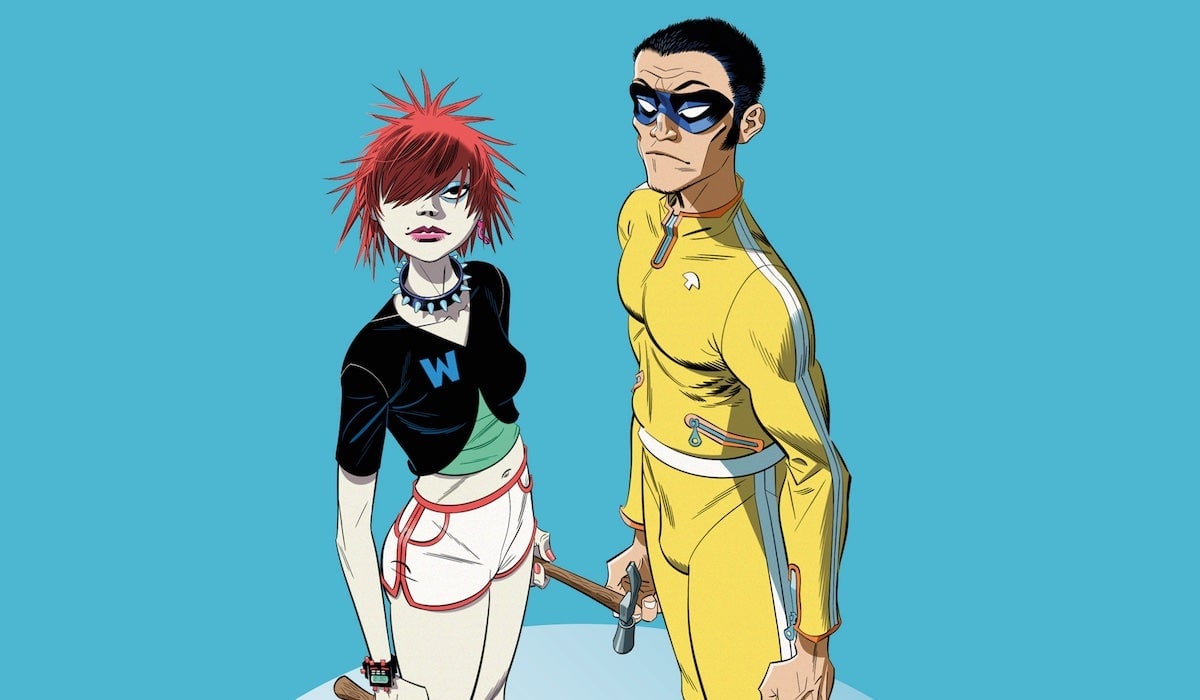
BIRD: Yes. I immediately picked up on that. I found that quite exciting though, because the prose didn’t just feel like it was trying to rip off someone else’s prose style. It was very authentic, a voice you came to yourself.
WAKEHAM: Absolutely. Thank you. When I got the books, I had been so busy making them and making decisions around typography, touching-up art, and actually writing it that I hadn’t read the comics back to back and then right through into the prose. The first time I did it, I got to the first page of the prose and nervously thought ‘Oh shit, is this going to feel like the same storyworld as the comics?’. I finished the first chapter, and it just wowed me. It was still the same characters and the same world, but entirely different too. It was a big relief. I was really aware that I was taking a big swing, and you can either hit or miss. I didn’t know if it had hit until I had the physical book in my hand! I’m not saying I knew I smashed it out of the park when I read it, but I knew it worked. Whether others like it is something you have no control over.
There was one chapter I got stuck on, focused on Bill and Elanor. I got to it, and it was the only chapter I had writer’s block with. Trying to find what the chapter was really about. It made sense when I wrote the outline, but finding the way through was really difficult. I love that chapter now. Mainly because it was a hurdle, but I got over it. I approached writing each chapter in a way that it could be read singularly, as one adventure per chapter, where each chapter wraps itself up but still pushes the story forward. The Bill/Elanor chapter is what would be called in TV a ‘Bottle Episode’. It was a little story of its own, about them and their issues, but still within the larger narrative.
Jamie’s an ideas fountain. You get a lot of Gorillaz fans who try to create a strict, linear narrative out of the lore, and that’s just not how he works. Murdoc might say something, which contradicts something else, because Jamie found it fun at the time. In Get the Freebies, he created this boyfriend character for Whitey in the first episode and he never really appeared again. That’s Bill. I wanted to use that and explore what he must have felt, alongside her best friend Elanor. Elanor’s based on lots of people we knew. In the comics, she had injected plutonium into her face to get superpowers, but was left scarred instead. A nuclear bomb goes off towards the end of the first season of the comics, so I figured that might have awakened her dormant powers!
Writing the prose was great because I had more space to explore minor characters and give them room to grow than I might otherwise do in a comic book format.
BIRD: The path to publishing the Phoo Action deluxe edition was long and often dramatic. What was the most rewarding part of the process for you?
WAKEHAM: Getting the physical book for the first time. For people who don’t know, it’s published by Titan Comics now, who are one of the oldest and best British publishers. I had done a deal before with an American company that had put out some Gorillaz books, and it seemed like a good way to do it at the time. On paper, it made sense to put the book out that way, as they had a big mailing list of Gorillaz fans who the books might potentially appeal to. They turned out not to be the right publisher for various reasons, but we had contractual obligations to them and had to wait for that contract to end in order to get the work back.
The book was supposed to come out on the 25th anniversary of Get The Freebies appearing in The Face, but it ended up coming out two years later. There was a lot of production work that still had to be done after we got the rights back from the original publishers. Contracts take forever, also! When we did the first deal, it took a year, which left me months to make the entire book. That first version didn’t even have an editorial pass done on it. I wrote the whole prose novel in three months. There were lots of such ‘joys’ along the way but when I finally held the book in my hand – I had spent months looking at it through digital copies – and it was the first time I had seen all the materials I had spent so long choosing, like the cloth binding and specialty paper stocks. It had all come together. It was a great moment. It was real.
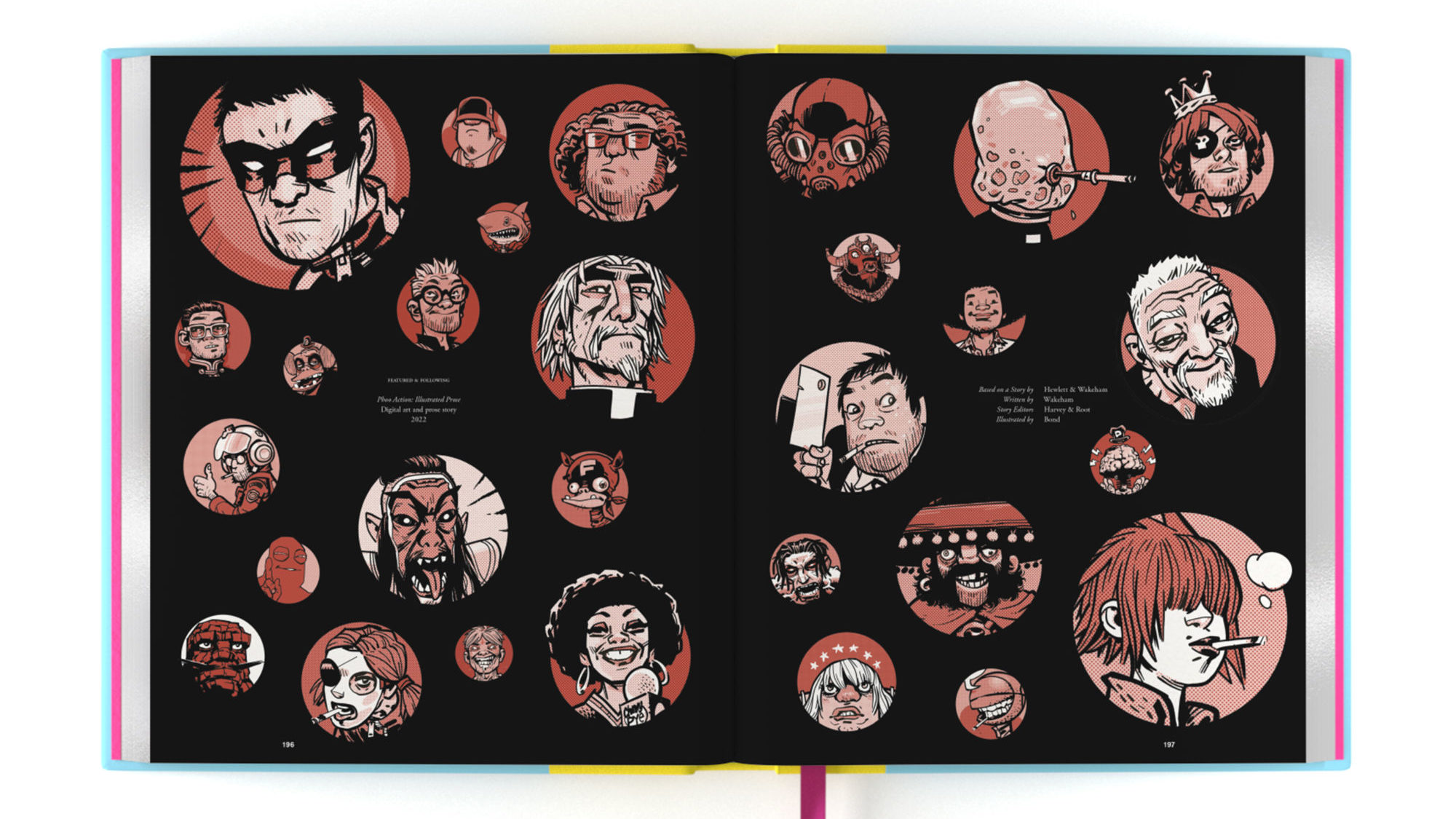
BIRD: I remember holding the book for the first time myself and you can see that it’s such a labour of love. Every choice feels so deliberate.
WAKEHAM: Yeah! The bookmark ribbon, for example, the process had me looking at every different type of material, different colours, and how it could connect with the envelope and the end papers. In this digital age, you can merely interact with the book online, but it was created to be a big, lush coffee table book. The size of it, the quality of the material. I knew it would cost a lot of money to buy, so I wanted it to be worth it.
BIRD: You got to host a Phoo Action launch party at the Cartoon Museum in London, which I was lucky enough to attend. What was that experience like for you?
WAKEHAM: It was lovely. Getting people together. There were people there that I knew, but that I was physically meeting for the first time. James Harvey, whom I hired to work with me as one of the many new contributors to the book, was my story editor on the prose. He and his partner Penelope Root worked hand in hand with me writing the prose novel. I’d do a first draft of every chapter, send it to them, they’d edit it and send it back to me. We’d have story meetings that went up to seven hours. I met him physically for the first time at that event! He’s an artist in his own right and has a book out at the moment called UK IN A BAD WAY, which I highly recommend. You can see the influence of the generation of British comics artists I grew up working with, like Jamie and Phillip Bond. It was good to have people together and recognise what we’d done. I hired Billy Shaughnessy, a well-known Gorillaz fan artist, who helped me with the book. I did that when I worked on Gorillaz as well. I brought in members of the fan community, so it was great to see Billy take their first steps into the industry as opposed to just being a fan. That’s how we all start out, as fans of stuff.
BIRD: I met Billy at the launch party and we had a conversation which was so strange to me because I quickly realized I knew their work. It was funny for me as someone else who was simply a fan until I ended up in the industry.
WAKEHAM: There’s a piece of artwork that Billy retouched that was so seamlessly done. It was faultless. Other pieces have been retouched, and I could see the difference because I know Jamie’s work so intimately, but the piece they did blew my mind. It was so perfect. For the standard edition coming later this year, Billy and I decided we would run a fan-art competition together.
BIRD: You just set me up brilliantly there. You launched a competition recently for fans to create their best works of Phoo Action-inspired art. Has the fan response to the series impacted your view on it over time?
WAKEHAM: I had a few things that I had planned to put into the first edition of Phoo Action, including a fan art section. The book was already so fucking big, so we decided to leave the fanart for now, but now it has worked out better because by the time the book came out, the community grew even more. I absolutely love this new Phan Art section for the standard edition. The work is brilliant. It’s a small community, but the people who are into it are really into it. James said something to me at some point; there’s a fan living in Japan, who’s a fashion designer, and who looks and dresses almost identically to Whitey – and he told me that I’d ‘moved the needle.’
Putting this book together was a labour of love. I’m not saying this in a disparaging way, but there were publishers who I spoke to who would be entirely happy if I just put out a trade paperback of the comics, but I knew I had more to share. There are all the press photographs for the pilot that never came out, Jamie’s process art, there’s a story I’ve got to tell that’s been in me for twenty-five years.
Jamie doesn’t share much from Phoo Action, but when he does, you can see the difference immediately. His biggest Phoo Action posts on his own account have nearly the same amount of likes and attention as his Gorillaz ones, which makes me incredibly proud.

BIRD: I think it’s a testament to the material that in a world where so many things are trying to grab your attention and your time, for fans to take the time and effort to craft something in honour of the series speaks to how good it is.
WAKEHAM: It’s amazing. If you go on the Phoo Action Instagram page, I have five or six highlights of fan art through the ages. I try to engage with everybody who does a piece of art. You can’t take that for granted. I know what it takes to take time out, sit, draw, color a piece, and post it. Jamie can’t engage with everyone who does a piece of Gorillaz fan art, but I can take the time to have a chat with the Phoo Action fans. I’m always very clear with boundaries, and I make sure things remain appropriate, and I sometimes have to remind people that there are things I’m not the person to talk to about.
I’ve brought on Billy but other fans as well, including Lobotomy Pop, aka Dawson Hogan, who recently was commissioned by Gorillaz to do official shirts, and I’d had him work on the book before that all happened for him. There’s a double-page spread in Phoo Action of Terry hallucinating at The Face Christmas party, which turns into ‘Gallagher’s Island’. All the ’90s celebrities are on it while Terry is running around tripping balls! I was aware that younger fans wouldn’t know who all of those celebrities are, so I had Dawson make a key for everyone to understand.
BIRD: Late 90’s music, fashion, and style are back in vogue again, full swing.
WAKEHAM: Yeah!
BIRD: Is there anything you hope stays in the 90s?
WAKEHAM: If you read the book, you’ll see how scathing Whitey’s attitude is towards anything that doesn’t cut muster for her. I could name and shame so many things and people from then, but I’m not sure there’s much use in doing that. What I did want to consign to the 90s, in the writing of the book, was the idea that we’d figured everything out. There was a feeling that we’d sorted out racism, sexism, and inequality. The people saying that though, were mostly just us young white guys. It didn’t all affect us. So, it was easy for us to say that. The work is never done, though; it’s something each generation does and has to do. The Boomers did work in the 1960s, with second-wave feminism and civil rights. Yeah, they bought houses cheap and sold off public utilities, but – without being glib – we are all human. Mistakes are made. So, I’d like to leave that well and truly in the 90s, that sense of self-righteousness and privilege that we had, which meant we thought we had consigned those problems to the past, but that our generation went on to perpetuate.
BIRD: I’ve done questions like this before, and a consistent theme seems to be ‘it’s more complicated than we thought it was.’ Twenty years ago, it seemed all figured out, but life reminds you that things aren’t that simple. When you can go back and revisit an older work, you can’t judge yourself for how you felt at the time, but you can decide what you can do about that going forward.
WAKEHAM: You end up in conversation with yourself. You have to be careful not to throw out the baby with the bathwater. We thought we were being allies and doing the right thing, but you have to look back at it and realise where you missed the mark. We had good intentions, but everyone has made a mistake at some point, and if you take responsibility, even if you can’t undo it, you can own it and try to do better. The prose deals with a lot of topics, and I’m sure I got some of that wrong, but maybe that’s okay too.

BIRD: What advice would you give writers who want to create something authentically reflective of themselves, akin to Phoo Action?
WAKEHAM: To be authentically reflective of yourself, you have to know yourself. Everyone’s looking for the shortcuts in life. There’s plenty of so-called ‘life coaches’ out there, people trying to get you to buy their course. You’ll hear people argue they give good advice, but people like Andrew Tate just recycle basic gym training protocols and simple financial advice. He’s just a raging misogynist. If you don’t know yourself, you can easily get pulled into things like that. They want to give you a shortcut. Even if that’s what you want, they’re not going to give it to you.
The way you will find yourself is by living. I mean, some people are really gifted with great insight and write masterpieces in their youth, and have often lived an incredibly traumatic life, or even an incredibly balanced one, that affords them their ability to express themselves. Most of us are somewhere in between, moderately fucked up, trying to create while managing our shit. If you want to be authentic with your art, you have to get to the bottom of your shit, yourself. If you don’t, your work will reflect your problems. You can just barrel into it, and maybe your experience and what you have to say will connect with a zeitgeist. That’s when people get incredibly famous and popular. There’s always the voice of a generation, but to express yourself, you have to know who you are.
BIRD: Thank you so much for your time.
